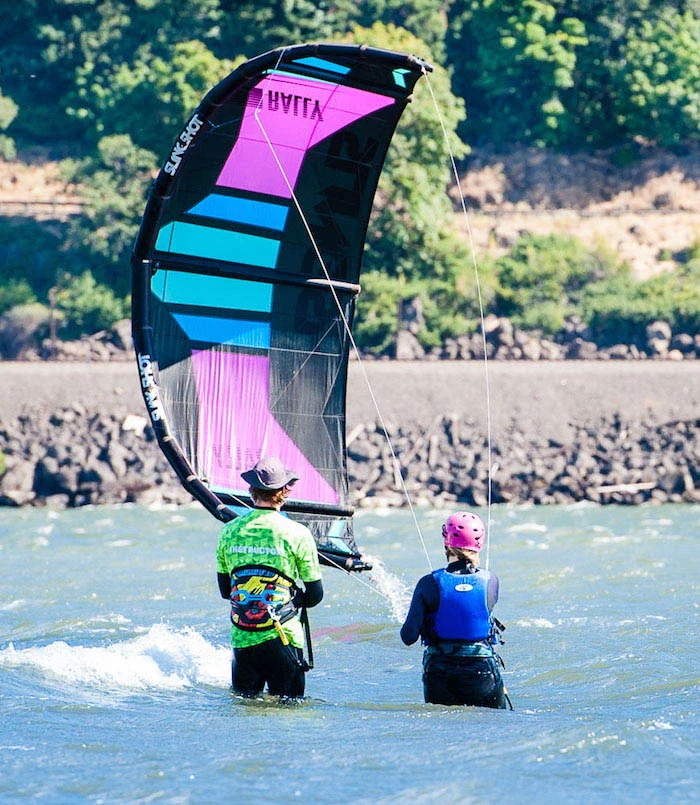Understanding the Gorge’s Unique Conditions
Weather and Wind Patterns
The Columbia River Gorge is known for its distinct wind conditions, which are shaped by the region’s geography. The Gorge functions as a natural wind tunnel where cool marine air from the west meets warmer inland air, resulting in consistent and powerful winds ideal for kiteboarding. Typically, wind speeds range between 15 to 35 mph, providing a reliable environment for both learning and refining skills. It is important to monitor wind forecasts regularly, as conditions can change quickly. Resources like NewWave Kiteboarding offer detailed insights into the best times for kiteboarding based on seasonal wind patterns.
Water Conditions
Water conditions in the Gorge can vary significantly, and understanding these is essential for beginners. The Columbia River’s water temperature ranges from 50 to 70 degrees Fahrenheit, so wearing a wetsuit is recommended, especially during cooler months. Currents can be strong, particularly near the center of the river, so it is advisable to stay closer to the shore where currents are less intense. Safety should always be a priority; therefore, understanding local conditions and potential hazards, such as submerged rocks or sudden wind gusts, is vital.
Best Time to Visit
The prime kiteboarding season in the Gorge runs from June through September, when the winds are most consistent, and the weather is warm. During these months, you can expect vibrant kiteboarding activity and numerous events. However, the shoulder months of May and October can also offer excellent conditions with fewer crowds. For those planning a trip, it is helpful to consult a kiteboarding travel guide to ensure the timing aligns with personal preferences and skill levels.
Essential Gear for Kiteboarding in the Gorge
Kiteboard and Kite Selection
Choosing the right kiteboard and kite is crucial for beginners. Kite size is typically determined by the rider’s weight and the wind conditions. For novices, a larger kite can provide more stability, while a smaller kite is easier to control in high winds. As for the board, a larger board can offer more buoyancy and make it easier to stand up and balance. Local shops in Hood River offer a range of equipment tailored to beginners and are a great resource for advice on selecting the right gear.
Safety Gear
Safety gear is an essential part of kiteboarding, especially for those new to the sport. Helmets and life vests are non-negotiable, providing crucial protection in case of falls or unexpected gusts. It is also advisable to wear impact vests and harnesses designed for kiteboarding, which offer additional protection and control. Local rental shops often include safety gear in their packages, ensuring that even first-timers are adequately equipped for a safe experience.
Local Rental Options
Hood River is home to numerous rental shops offering a wide selection of kiteboarding gear. These shops provide everything from beginner-friendly kites and boards to advanced equipment for seasoned kiteboarders. Rental packages often include helmets, life vests, and wetsuits, ensuring that newcomers have everything they need for a safe and enjoyable experience.
Learning to Kiteboard: Lessons and Schools
Top Kiteboarding Schools
Hood River boasts several renowned kiteboarding schools, each offering unique programs tailored to beginners. Schools like Big Winds and Gorge Kiteboard School are highly recommended for their experienced instructors and comprehensive lessons. These schools provide structured courses designed to build confidence and skills progressively, ensuring a robust foundation in kiteboarding.
Lesson Structure and What to Expect
A typical beginner lesson in Hood River includes an introduction to the equipment, safety protocols, and basic techniques such as kite control and body positioning. Lessons usually last between two to three hours and are often conducted in small groups to allow for personalized attention. As skills develop, lessons can progress to include advanced techniques like water starts and transitions.
Finding the Right Instructor
Choosing the right instructor can make a significant difference in your learning experience. Look for instructors who are certified by recognized bodies like the International Kiteboarding Organization (IKO) or the Professional Air Sports Association (PASA). Personal recommendations, online reviews, and consultations with schools can also help identify instructors who are patient, knowledgeable, and experienced in teaching beginners.
Exploring the Hood River Kiteboarding Community
Community Events and Competitions
The Hood River kiteboarding community is vibrant and welcoming, with numerous events and competitions held throughout the season. Events like the Bridge of the Gods Kitefest offer opportunities for beginners to participate in fun races and showcase their developing skills. Spectating at these events can also provide valuable insights into advanced techniques and the local kiteboarding culture.
Connecting with Locals
Joining local kiteboarding groups and forums is an excellent way to connect with other enthusiasts and gain insider tips. Platforms like Facebook and Meetup host several groups where locals share advice, organize meetups, and discuss conditions. Engaging with the local community can significantly enhance your experience and provide a supportive network for your kiteboarding journey.
Après-kiteboarding Activities
After a day on the water, Hood River offers plenty of dining and social options. The town is known for its lively atmosphere, with numerous bars and restaurants where kiteboarders gather to share stories and unwind. Places like Pfriem Family Brewers and Solstice Wood Fire Cafe are popular spots to enjoy a meal and reflect on the day’s adventures.
Practical Tips for a Successful Kiteboarding Adventure
Physical Preparation
Kiteboarding is a physically demanding sport, requiring strength, endurance, and flexibility. Engaging in regular exercise, focusing on core strength and cardiovascular fitness, can prepare your body for the challenges of kiteboarding. Activities like yoga and pilates can improve balance and flexibility, making it easier to control the kite and board.
Understanding Local Regulations
It is essential to familiarize yourself with the local regulations and etiquette before heading out on the water. Certain areas of the Gorge may have restrictions or designated zones for kiteboarding to ensure safety and environmental protection. Adhering to local rules and showing respect for other water users is crucial for maintaining a positive and safe kiteboarding environment.
Packing Essentials
When preparing for a kiteboarding trip to the Gorge, packing the right essentials can make a significant difference. A checklist might include a wetsuit, sunscreen, sunglasses, and a reusable water bottle. It is also wise to bring a first-aid kit, snacks, and a change of clothes for après-kiteboarding activities.



